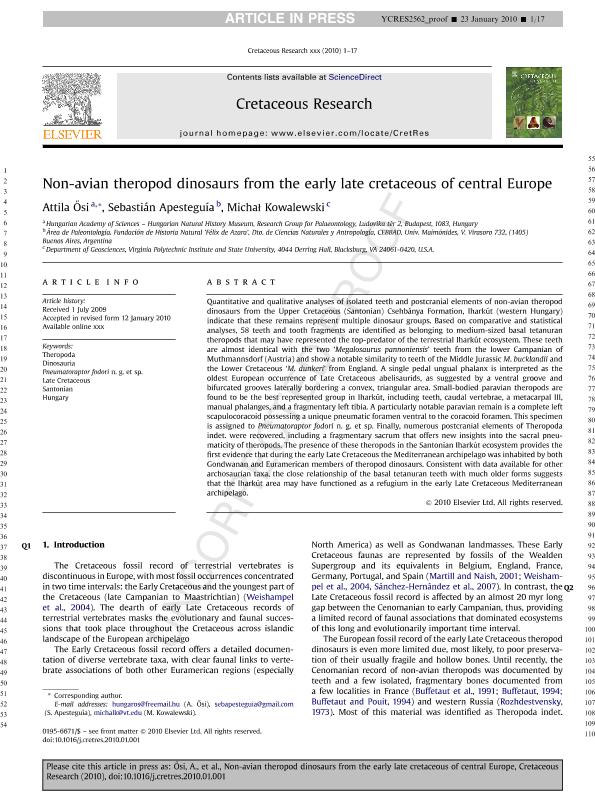Artículo
Non-avian theropod dinosaurs from the early late cretaceous of central Europe
Fecha de publicación:
06/2010
Editorial:
Academic Press Ltd - Elsevier Science Ltd
Revista:
Cretaceous Research
ISSN:
0195-6671
Idioma:
Inglés
Tipo de recurso:
Artículo publicado
Clasificación temática:
Resumen
Quantitative and qualitative analyses of isolated teeth and postcranial elements of non-avian theropod dinosaurs from the Upper Cretaceous (Santonian) Csehbánya Formation, Iharkút (western Hungary) indicate that these remains represent multiple dinosaur groups. Based on comparative and statistical analyses, 58 teeth and tooth fragments are identified as belonging to medium-sized basal tetanuran theropods that may have represented the top-predator of the terrestrial Iharkút ecosystem. These teeth are almost identical with the two '. Megalosaurus pannoniensis' teeth from the lower Campanian of Muthmannsdorf (Austria) and show a notable similarity to teeth of the Middle Jurassic M. bucklandii and the Lower Cretaceous '. M. dunkeri' from England. A single pedal ungual phalanx is interpreted as the oldest European occurrence of Late Cretaceous abelisaurids, as suggested by a ventral groove and bifurcated grooves laterally bordering a convex, triangular area. Small-bodied paravian theropods are found to be the best represented group in Iharkút, including teeth, caudal vertebrae, a metacarpal III, manual phalanges, and a fragmentary left tibia. A particularly notable paravian remain is a complete left scapulocoracoid possessing a unique pneumatic foramen ventral to the coracoid foramen. This specimen is assigned to Pneumatoraptor fodori n. g. et sp. Finally, numerous postcranial elements of Theropoda indet. were recovered, including a fragmentary sacrum that offers new insights into the sacral pneumaticity of theropods. The presence of these theropods in the Santonian Iharkút ecosystem provides the first evidence that during the early Late Cretaceous the Mediterranean archipelago was inhabited by both Gondwanan and Euramerican members of theropod dinosaurs. Consistent with data available for other archosaurian taxa, the close relationship of the basal tetanuran teeth with much older forms suggests that the Iharkút area may have functioned as a refugium in the early Late Cretaceous Mediterranean archipelago.
Palabras clave:
Theropoda
,
Late Cretaceous
,
Santonian
,
Hungary
Archivos asociados
Licencia
Identificadores
Colecciones
Articulos(SEDE CENTRAL)
Articulos de SEDE CENTRAL
Articulos de SEDE CENTRAL
Citación
Odouble acutesi, Attila; Apesteguía, Sebastián; Kowalewski, Michal; Non-avian theropod dinosaurs from the early late cretaceous of central Europe; Academic Press Ltd - Elsevier Science Ltd; Cretaceous Research; 31; 3; 6-2010; 304-320
Compartir
Altmétricas




